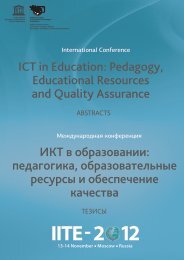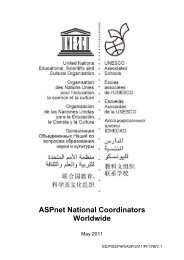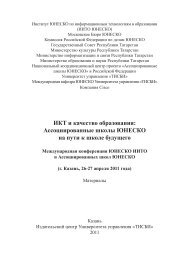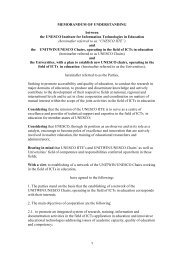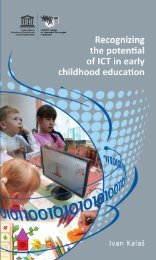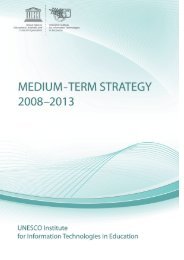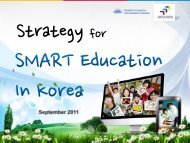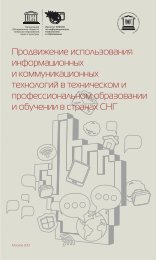Towards global education: The need for the 21st ... - unesco iite
Towards global education: The need for the 21st ... - unesco iite
Towards global education: The need for the 21st ... - unesco iite
Create successful ePaper yourself
Turn your PDF publications into a flip-book with our unique Google optimized e-Paper software.
<strong>Towards</strong> <strong>global</strong> <strong>education</strong>: <strong>The</strong> <strong>need</strong> <strong>for</strong> <strong>the</strong> <strong>21st</strong> century<br />
literacies<br />
Professor Tapio Varis<br />
UNESCO Chair in Global e-Learning<br />
University of Tampere, Finland<br />
Unesco World Conference of Higher Education in 2009 concluded, among o<strong>the</strong>r things,<br />
that “Higher <strong>education</strong> institutions, through <strong>the</strong>ir core functions (research, teaching and<br />
service to <strong>the</strong> community) carried out in <strong>the</strong> context of institutional autonomy and<br />
academic freedom, should increase <strong>the</strong>ir interdisciplinary focus and promote critical<br />
thinking and active citizenship” Fur<strong>the</strong>rmore, “International cooperation in higher<br />
<strong>education</strong> should be based on solidarity and mutual respect and <strong>the</strong> promotion of<br />
humanistic values and intercultural dialogue.”<br />
Educators have committed to <strong>the</strong>se objectives clearly as observed by Elise Boulding<br />
already in 1988: “<strong>The</strong> objective is to create a peaceful, inter-dependent world which<br />
would be a good place <strong>for</strong> people to live. No one society can impose a universal order<br />
acceptable to all o<strong>the</strong>r societies. <strong>The</strong> creation of species identity that will encompass<br />
cultural diversity is a major challenge “ (Boulding 1988)<br />
However, <strong>the</strong> technology-push <strong>global</strong> thinking is dominated by economic technocracy<br />
and does not reflect enough <strong>the</strong> nature of multicultural world. One example of <strong>the</strong> current<br />
<strong>global</strong> innovation network of leading universities in <strong>the</strong> case of Nokia is given in<br />
appendix 1.<br />
One way of approaching <strong>the</strong> problems of <strong>global</strong> university <strong>education</strong> is to construct a<br />
taxonomy or staircase of different tiers. Figure 1 below is constructed from <strong>the</strong> analysis<br />
of Edward Guiliano, President and CEO, New York University of Technology (2009):<br />
1
Figure 1. Toward a Taxonomy of Global Academic programs<br />
In Guiliano´s approach <strong>the</strong> lowest tier is composed of non-credit-bearing affiliations<br />
including conferences, training programs, and extended <strong>education</strong>-type offerings. <strong>The</strong>se<br />
are very close to friendship alliances which include co-operation agreements and memos<br />
of understanding <strong>for</strong> research and student as well as faculty exchanges.<br />
<strong>The</strong> next levels would be composed of studies abroad and exchanger programs. <strong>The</strong>se<br />
programs mean studying or living abroad with ano<strong>the</strong>r faculty of <strong>the</strong> same university in<br />
ano<strong>the</strong>r country. In general, full degrees cannot be earned at <strong>the</strong>se sites, but courses and<br />
study at <strong>the</strong>m fulfill requirements <strong>for</strong> degrees at <strong>the</strong> home campus. Dual degree programs<br />
leverage strengths of each university and campus. Students study both curricula and<br />
attend at both locations. Ano<strong>the</strong>r type of international programs is a degree or creditbearing<br />
certificate programs <strong>for</strong> <strong>for</strong>eigners.<br />
A multinational university or international university means degree-granting branch<br />
campuses, generally staffed by faculty not affiliated with home campus, autonomous or<br />
semi-autonomous administration and governance extending to <strong>the</strong> curriculum. Degrees<br />
carries name of home institution but usually with a separate designation.<br />
<strong>The</strong> highest level in Guiliano´s tiers is <strong>global</strong> university. For him this means one degree,<br />
one curriculum offered by a university at one or more <strong>global</strong> locations, characteristics<br />
include exchange of faculty and students, and virtual or distance-learning classrooms.<br />
This New York Institute of technology model includes “some degree of practical<br />
´glocalization´, but a true outward-looking <strong>global</strong> university with one set of standards and<br />
outcomes worldwide, one administration, and where students, faculty and ideas freely<br />
2
flow without borders, evolving <strong>global</strong> understandings and new ´<strong>global</strong>ized´ content over<br />
time” (Guiliano 2009).<br />
In a way this approach is very close to our own model of Global University System<br />
(GUS) which we have developed in <strong>the</strong> Unesco Chair in Global e-learning at <strong>the</strong><br />
University of Tampere, Finland. <strong>The</strong> Global University System (GUS) [Utsumi, et al,<br />
2003] is a free (volunteer-based, multi-sponsored) grass-roots initiative to widen access<br />
to higher <strong>education</strong> and vocational <strong>education</strong> and training, and to help participating<br />
institutions to meet local <strong>need</strong>s in ways that are locally-appropriate and <strong>global</strong>lyin<strong>for</strong>med.<br />
<strong>The</strong> GUS encourages <strong>the</strong> integration of untapped or poorly-deployed human<br />
and technical resources, particularly to facilitate <strong>the</strong> diffusion worldwide of low-cost<br />
means of access to <strong>the</strong> communication and <strong>education</strong> resources that <strong>the</strong> privileged West<br />
takes <strong>for</strong> granted. Since it began in 1999, <strong>the</strong> GUS has become <strong>global</strong>. It works in <strong>the</strong><br />
major regions of <strong>the</strong> globe with partnerships of higher <strong>education</strong> and healthcare<br />
institutions.<br />
Figure 2. <strong>The</strong> Mission of <strong>the</strong> Global University System (GUS)<br />
3
This project has been modeled very much with <strong>the</strong> inspiration of <strong>the</strong> best traditions of<br />
American thinking: We have believed that <strong>the</strong> culture of America is particularly suited<br />
<strong>for</strong> <strong>the</strong> creative mind because it has emphasized:<br />
• Extreme freedom of thought,<br />
• An emphasis on independent thinking,<br />
• A steady immigration of new minds,<br />
• A risk-taking culture with no stigma attached to trying and failing,<br />
• A non-corrupt bureaucracy, and<br />
• Financial markets and a venture capital system that are unrivaled<br />
at taking new ideas and turning <strong>the</strong>m into <strong>global</strong> products.<br />
<strong>The</strong> process of <strong>global</strong>ization and has brought our attention to <strong>the</strong> complexities of <strong>the</strong><br />
multicultural world and challenges of <strong>the</strong> true nature of <strong>the</strong> emerging <strong>global</strong> knowledge<br />
society. <strong>The</strong> Unesco study “<strong>Towards</strong> Knowledge Societies” (2005) revealed that <strong>the</strong>re is<br />
a general agreement on <strong>the</strong> expression ”knowledge societies” but not of <strong>the</strong> content of it.<br />
We can ask; are we endorsing <strong>the</strong> hegemony of <strong>the</strong> techno-scientific model in defining<br />
legitimate and productive knowledge? Should <strong>the</strong> term “Digital Age” be replaced by<br />
multicultural world? How do we promote <strong>the</strong> spirit of knowledge sharing and caring and<br />
nmew humanism?<br />
<strong>The</strong>se were some of <strong>the</strong> concerns <strong>for</strong> me to work with professor Jose Manuel Perez<br />
Tornero, Autonomous University of Barcelona, <strong>for</strong> <strong>the</strong> Unesco Institute <strong>for</strong> In<strong>for</strong>mation<br />
technologies in <strong>education</strong> (IITE) <strong>for</strong> <strong>the</strong> publication “Media literacy and new humanism”<br />
(2010). We understand civilisation as meaning a specific state of technical development<br />
which corresponds to a precise evolution in <strong>the</strong> manmade environment in which humanity<br />
operates, and which is supported by a given set of knowledge, codes, languages, skills<br />
and intellectual capacities related precisely to this manmade environment. <strong>The</strong>se<br />
intellectual capacities are known in <strong>the</strong>ir broad sense by <strong>the</strong> name of culture, and we shall<br />
call <strong>the</strong> shift from one state of civilisation to ano<strong>the</strong>r evolution in <strong>the</strong> civilising process.<br />
In our view <strong>the</strong> threshold of <strong>the</strong> 21 st century based on <strong>the</strong>se concepts, can be described<br />
as.:<br />
a) A technological civilisation based on <strong>the</strong> digitalisation of in<strong>for</strong>mation;<br />
b) A media culture organised around <strong>the</strong> media and <strong>the</strong>ir convergence; and that it is<br />
subjected to<br />
c) A breakneck process of civilising evolution that is only gaining momentum.<br />
<strong>The</strong> key to this state of affairs must be sought in <strong>the</strong> fact that during <strong>the</strong> last few years of<br />
<strong>the</strong> 20 th century and early years of <strong>the</strong> 21 st century, digital technologies and <strong>the</strong> new<br />
media (ICT) have come to occupy <strong>the</strong> epicentre of our lives. <strong>The</strong>y are thus a key factor in<br />
this specific civilising stage.<br />
4
<strong>The</strong>y are responsible <strong>for</strong> having constructed <strong>the</strong> hypertechnological manmade<br />
environment in which almost all people and objects have been endowed with a kind of<br />
digital interface, so we work, live and interact in a digitally enriched environment, in a<br />
kind of digital bubble.<br />
In brief, we can identify some <strong>global</strong> trends in technology and <strong>education</strong>. First of all, <strong>the</strong><br />
world is becoming increasingly multicultural. <strong>The</strong>re is a general confusion of <strong>the</strong> essence<br />
of universalism and uniqueness in <strong>the</strong> multicultural world. Globalism has brought such<br />
quantitities as technics, markets, tourism, and in<strong>for</strong>mation but universalism deals with<br />
values like human rights, liberties, culture, and democracy. Each culture and language is<br />
unique. Globalism tends to dominate over <strong>the</strong> awareness of human values.<br />
In my understanding we face three kinds of problems. First we have to try to understand<br />
what is <strong>the</strong> learning process of becoming literate and what does communication<br />
competence and media skills mean in <strong>the</strong> in<strong>for</strong>mation society. Second, we have to<br />
analyze <strong>the</strong> increasing neo-illiteracy. Third, we should discuss of what kind of skills and<br />
competences should people have in order to become active citizens now as compared to<br />
<strong>the</strong> earlier skills of writing and reading.<br />
In an intercultural world communication necessarily mediates different values and<br />
cultural behaviors. Great civilizations and cultures have very different patterns of<br />
communication and use different senses in a different way. In consequence, if a truly<br />
<strong>global</strong> in<strong>for</strong>mation society is to be created, more attention should be given to <strong>the</strong> diversity<br />
of cultures and <strong>the</strong> co-existence of different civilizations and cultures. For <strong>the</strong><br />
development of our own language it is necessary to rethink <strong>the</strong> whole <strong>education</strong> system,<br />
from primary to higher, and understand <strong>the</strong> links to multiliteracies, multimodality and<br />
multimediality”<br />
<strong>The</strong> study of complexity has brought science closer than ever to art. Knowledge has gone<br />
through a cycle from non-specialism to specialism and is now moving back to<br />
interdisciplinarity, even transdisciplinarity. Art deals with <strong>the</strong> sensual world (media as <strong>the</strong><br />
extension of senses) and <strong>the</strong> holistic concept of human being. Traditional knowledge has<br />
been disciplinary based although increasingly interdisciplinary. In <strong>the</strong> vocational field,<br />
knowledge is also contextual and <strong>need</strong>s to be created in application – learning by doing.<br />
This also reflects local and regional realities. <strong>The</strong> Western philosophy is characterized by<br />
analytical, scientific, objective, rational, and critical thinking while <strong>the</strong> Eastern approach<br />
is characterized by syn<strong>the</strong>sis, literature and art with a subjective and emotional thinking.<br />
Both cannot and should not dominate <strong>the</strong> o<strong>the</strong>r, but should have close dialogues between<br />
<strong>the</strong>m. In a sense, many of <strong>the</strong> basic issues were already discussed in ancient Greece by<br />
Socrates, Plato, and Aristotle.<br />
Aristotle´s Poetics is of particular importance to understand <strong>the</strong> balance between different<br />
senses of <strong>the</strong> human being and <strong>the</strong> combination of sound, drama, and text like in modern<br />
multimedia. Also Aristotle´s definition of rhetoric as <strong>the</strong> faculty of discovering in any<br />
given case <strong>the</strong> available means of persuasion is a relevant approach to analyze <strong>the</strong><br />
5
influence of modern media.<br />
In order to learn new technologies and become digitally literate, new <strong>for</strong>ms of learning<br />
paths have to be developed utilizing all <strong>for</strong>ms of learning, especially at work and<br />
non<strong>for</strong>mal environments. At <strong>the</strong> same time, special attention should be given to teacher<br />
<strong>education</strong> in ICT skills and competencies. <strong>The</strong> period of transition in which we are now<br />
living differs from <strong>the</strong> periods of change of older dominant media. Traditional print and<br />
electronic media were introduced within a period of reasonable length, and when we<br />
moved to <strong>the</strong> active use of a new <strong>for</strong>m of communication, we could also have a rough<br />
estimation of <strong>the</strong> economic and social impacts of this transition and train new<br />
professionals <strong>for</strong> <strong>the</strong> media and support people <strong>for</strong> <strong>the</strong> institutions. Now different <strong>for</strong>ms<br />
of communication and technologies integrate and converge with a speed that hardly<br />
anyone has <strong>the</strong> time or ability to assess all of <strong>the</strong> consequences, real possibilities, or<br />
problems.<br />
<strong>The</strong> use of ICT and digital skills in per<strong>for</strong>ming art, craft, and o<strong>the</strong>r fields require a team<br />
work with special skills. <strong>The</strong> trend of digitalization does not mean that everything<br />
traditional should be rejected. New communicative inventions have always also<br />
destroyed something valuable, and special attention should be given to <strong>the</strong> diversity of<br />
approaches in <strong>the</strong> ICT applications. A blended approach is often adopted. Most essential<br />
in this new learning environment is <strong>the</strong> fact that <strong>the</strong> learner is constantly facing epistemic<br />
conflicts when a problem is presented that <strong>need</strong>s to be solved but lies outside <strong>the</strong><br />
learner’s current repertoire. Most of <strong>the</strong> problems of <strong>the</strong> in<strong>for</strong>mation society will be of<br />
that kind. <strong>The</strong> learner <strong>need</strong>s to proceed with self-regulation with an active engagement,<br />
which is <strong>the</strong> learner’s response to <strong>the</strong> conflict. <strong>The</strong> idea is to adjust and reconstruct<br />
thinking to deal with <strong>the</strong> learning problem at hand.<br />
<strong>The</strong> cultural dimension in <strong>the</strong> ICT applications also brings <strong>the</strong> dimension of feelings and<br />
<strong>the</strong> spirit of sharing and caring to <strong>the</strong> process. <strong>The</strong> social dimension requires inclusive<br />
policies. In an intercultural world communication necessarily mediates different values<br />
and cultural behaviors. Great civilizations and cultures have very different patterns of<br />
communication and use different senses in a different way. In consequence, if a truly<br />
<strong>global</strong> in<strong>for</strong>mation society is to be created, more attention should be given to <strong>the</strong> diversity<br />
of cultures and <strong>the</strong> co-existence of different civilizations and cultures<br />
People of <strong>the</strong> work <strong>for</strong>ce face two overlapping challenges. <strong>The</strong> first is to acquire <strong>the</strong> skills<br />
necessary to enter an increasingly digital job market, and <strong>the</strong> second is to continually<br />
improve those skills, and learn new ones, as life-long learning. Many studies suggest that<br />
workers around <strong>the</strong> world may not be keeping pace. It is widely believed that schools are<br />
failing to sustain <strong>the</strong> pipeline of employees who are adequately prepared to exploit new<br />
knowledge and skills.<br />
<strong>The</strong> first skill in <strong>the</strong> working life is to define <strong>the</strong> in<strong>for</strong>mation problem. It is not possible to<br />
look back <strong>for</strong> an answer from earlier practice since such does not exist. This is followed<br />
by identifying in<strong>for</strong>mation <strong>need</strong>ed in order to complete <strong>the</strong> task to solve <strong>the</strong> in<strong>for</strong>mation<br />
problem. <strong>The</strong>re is a wide consensus that all workers should be able to:<br />
6
- master appropriate tools to ga<strong>the</strong>r in<strong>for</strong>mation<br />
- understand <strong>the</strong> context of that in<strong>for</strong>mation<br />
- actively shape and distribute in<strong>for</strong>mation in ways that make it understandable and<br />
useful, and<br />
- exchange ideas, opinions, questions and experiences.<br />
People have always learned at work. According to Mr. Mikko Salminen, Nokia Learning<br />
Centre Network of Nokia Corporation, <strong>the</strong> paradigm of learning at corporate setting is<br />
rapidly shifting from skills development to capability management. <strong>The</strong> strong drivers<br />
behind <strong>the</strong> change are <strong>the</strong> ever increasing <strong>need</strong> <strong>for</strong> faster innovation cycles and <strong>the</strong> ability<br />
to support <strong>the</strong> strategic competency renewal (Salminen 2005).<br />
<strong>The</strong> new learning paradigm can be expressed as <strong>the</strong> 70-20-10 <strong>for</strong>mula of learning:<br />
- 70% of <strong>the</strong> capability is built through on-<strong>the</strong>-job development and real life<br />
experiences<br />
- 20% is built through coaching, assessments and increased self-awareness<br />
- 10% is acquired through structured learning deliveries such as instructor-ledtrainings<br />
and eLearning<br />
<strong>The</strong> learner will soon realize that by adapting this <strong>for</strong>mula he/she will make each day a<br />
learning day. <strong>The</strong> <strong>need</strong> to separately plan <strong>the</strong> time <strong>for</strong> learning and work disappears and<br />
learning becomes work as usual.<br />
However, this does not mean that we will invest less in learning and development, says<br />
Salminen. Basically, <strong>the</strong> <strong>for</strong>mula is about developing <strong>the</strong> right mindset <strong>for</strong> learning ra<strong>the</strong>r<br />
than making choices between learning events and modes of delivery. <strong>The</strong>re will always<br />
be room <strong>for</strong> skills based competency development, and certain enabling skills will<br />
continue to be delivered in a classroom, not to mention highly interactive leadership<br />
development where discussions and networking play a major role. In a similar fashion,<br />
eLearning is here to stay as an easily scalable and cost efficient delivery channel <strong>for</strong><br />
<strong>the</strong>oretical solutions.<br />
As <strong>the</strong> new working culture emphasizes <strong>the</strong> importance of lifelong learning, corporations<br />
are beginning to provide workers with <strong>the</strong> means to customize and direct <strong>the</strong>ir own<br />
learning experiences. <strong>The</strong>re are still several steps to be taken to improve employment<br />
opportunities <strong>for</strong> individuals and expand <strong>the</strong> innovative capabilities of companies.<br />
Everybody in working life and training is becoming more responsible <strong>for</strong> ensuring <strong>the</strong><br />
development of <strong>the</strong> knowledge and skills acquired.<br />
Jose Manuel Perez Tornero and myself identified five important dimensions of <strong>the</strong> new<br />
humanism that in comparisons to <strong>the</strong> old humanism of <strong>the</strong> renaissance <strong>need</strong> to be<br />
developed now in <strong>the</strong> 21 st century. If <strong>the</strong> <strong>global</strong> communication society has come hand in<br />
7
hand with disproportionate promises and unfulfilled utopias, today it is compulsory to<br />
examine and evaluate why this has transpired. It is now imperative to abandon blind trust<br />
in technology and to deepen our critical spirit. We <strong>need</strong> to develop an aware attitude that<br />
is capable of weighing <strong>the</strong> positive and negative effects of <strong>the</strong> changes, and one<br />
especially that is able to inspire new technical developments that jibe with human beings’<br />
aspirations.<br />
To accomplish this, we must first dissolve <strong>the</strong> axiom of spontaneous technological<br />
progress and accept <strong>the</strong> fact that when technological alternatives are chosen, progress is<br />
only one option among many. <strong>The</strong> positive development of <strong>the</strong> media technologies will<br />
depend on our ability to take <strong>the</strong> right decisions and gain cognizance of <strong>the</strong>ir potential<br />
impact. <strong>The</strong> <strong>global</strong> communication society harbours enormous potential, along with some<br />
risks. However, its full, positive realisation depends on whe<strong>the</strong>r humanity, including each<br />
and every one of us, gains in awareness and responsibility.<br />
From our standpoint, today this awareness must be media-related and humanistic. On <strong>the</strong><br />
one hand, as media-related, its main goal must be to monitor <strong>the</strong> development of <strong>the</strong><br />
media and be keenly aware of what it may represent <strong>for</strong> humanity, <strong>for</strong> better or <strong>for</strong> worse.<br />
On <strong>the</strong> o<strong>the</strong>r hand, this awareness must drive <strong>the</strong> values of a new humanism, and it must<br />
do so in many senses:<br />
a) In <strong>the</strong> sense that it must situate <strong>the</strong> human person at <strong>the</strong> core of this media<br />
civilisation, this new manmade, telecom world around us, just as in <strong>the</strong><br />
Renaissance <strong>the</strong> humanists managed to place human beings at <strong>the</strong> centre of a<br />
world which had been organised by <strong>the</strong>ology until <strong>the</strong>n.<br />
b) In <strong>the</strong> sense that this new awareness must drive <strong>the</strong> primacy of <strong>the</strong> critical sense<br />
towards technology and thus replace this trusting and ra<strong>the</strong>r unselective attitude<br />
that prevails today and <strong>for</strong>ces us to unconditionally accept technological<br />
innovation. This echoes how <strong>the</strong> humanists defended a free, critical interpretation<br />
of <strong>the</strong> classical texts and ultimately <strong>the</strong> autonomy of <strong>the</strong> intellect and <strong>the</strong> human<br />
person. While Renaissance humanism served as a critical filter of <strong>the</strong> values of its<br />
day by filtering mediaeval culture with classical culture, <strong>the</strong> new 21 st century<br />
humanism most foster a critical sense which is alert to <strong>the</strong> hypertechnologised<br />
environment and capable of discerning between what should be kept and what<br />
should be revamped.<br />
c) In <strong>the</strong> sense that while Renaissance humanism helped to “discover” <strong>the</strong> sense of<br />
self and biography and fostered a new <strong>for</strong>m of individual autonomy compared to<br />
<strong>the</strong> sometimes asphyxiating weight of traditionalist thinking, <strong>the</strong> new humanism<br />
must help to foster a sense of autonomy in a context in which <strong>global</strong><br />
communication can engender dependence and very subtle <strong>for</strong>ms of intellectual<br />
subjugation.<br />
d) In <strong>the</strong> sense that while Renaissance humanism was characterised by a “discovery”<br />
of new “worlds”, America first and <strong>for</strong>emost, but also Africa and Asia, giving rise<br />
8
to an “encounter” – often violent – between cultures and civilisations, <strong>the</strong> new<br />
humanism in <strong>the</strong> <strong>global</strong> communication society must prioritise a new sense of<br />
respect <strong>for</strong> multiplicity and cultural diversity and must support media<br />
development with <strong>the</strong> goal of consolidating <strong>the</strong> new culture of peace.<br />
e) Finally, in <strong>the</strong> sense that, just like Renaissance humanism, through <strong>the</strong> new media<br />
and humanistic awareness now is <strong>the</strong> time <strong>for</strong> us to be capable of reviving <strong>the</strong><br />
classical idea of cosmopolitan, universal citizen, with very clear rights and<br />
responsibilities, which entail a planet-wide commitment. We must foster a kind of<br />
citizenship that stimulates <strong>the</strong> idea that individuals view <strong>the</strong>mselves as <strong>the</strong> bearers<br />
of universal rights, as well as responsibilities which are also universal.<br />
Today, media awareness and <strong>the</strong> new humanism are inseparable. <strong>The</strong>y are <strong>the</strong> obligatory<br />
response to <strong>the</strong> <strong>for</strong>mation of a technological civilisation and a media culture.<br />
In order to learn new technologies and become digitally literate new <strong>for</strong>ms of learning<br />
paths have to be developed utilizing all <strong>for</strong>ms of learning, especially at work and non<strong>for</strong>mal<br />
environments. At <strong>the</strong> same time special attention should be given to teacher<br />
<strong>education</strong> in in<strong>for</strong>mation and communication skills and competences. <strong>The</strong> period of<br />
transition that we are now living differs from <strong>the</strong> periods of change of older dominant<br />
media. Traditional print and electronic media were introduced within a period of<br />
reasonable length and when we moved to <strong>the</strong> active use of a new <strong>for</strong>m of communication,<br />
we could also have a rough estimation of <strong>the</strong> economic and social impacts of it, and train<br />
new professionals <strong>for</strong> <strong>the</strong> media and support people <strong>for</strong> <strong>the</strong> institutions. Now different<br />
<strong>for</strong>ms of communication and technologies integrate and converge with a speed that<br />
hardly anyone has <strong>the</strong> time or ability to assess all of <strong>the</strong> consequences, real possibilities,<br />
or problems. In a positive sense, people may be able to speak more directly to each o<strong>the</strong>r<br />
without <strong>for</strong>mer restrictions.<br />
<strong>The</strong> cultural dimension in <strong>the</strong> communication and technology applications bring also <strong>the</strong><br />
dimension of emotions and affection and <strong>the</strong> spirit of sharing and caring to <strong>the</strong> process.<br />
<strong>The</strong> social dimension require inclusive policies. Internet does not automatically promote<br />
social understanding and integration. In an intercultural world communication necessarily<br />
mediates different values and cultural behaviours. Great civilizations and cultures have<br />
very different patterns of communication and use different senses in a different way. In<br />
consequence, if a truly <strong>global</strong> in<strong>for</strong>mation society is to be created, more attention should<br />
be given to <strong>the</strong> diversity of cultures and <strong>the</strong> co-existence of different civilizations and<br />
cultures.<br />
Perez Tornero and myself think that no matter how disperse and diverse it has been, <strong>the</strong><br />
international media literacy movement has always shared <strong>the</strong> idea – <strong>for</strong>mulated more or<br />
less explicitly – that it was necessary to reach a new media awareness. This media<br />
awareness would help us to achieve two key goals: a) ascertain <strong>the</strong> importance and<br />
influence of <strong>the</strong> media system in our everyday life, and b) develop <strong>the</strong> competences<br />
<strong>need</strong>ed to use <strong>the</strong> communication technologies bearing human goals and values in mind.<br />
9
<strong>The</strong> different aspects of media literacy are related to o<strong>the</strong>r fields, such as:<br />
a) critical thinking and an improvement of <strong>the</strong> capacities of selecting and processing<br />
in<strong>for</strong>mation;<br />
b) <strong>the</strong> problem-solving capacity;<br />
c) improvements in expressive, communicative and interactive capacities;<br />
d) civic participation and active citizenship.<br />
Today media literacy is one of <strong>the</strong> major objectives of <strong>education</strong>al and communication<br />
policies, and at <strong>the</strong> same time <strong>the</strong> attaining this media literacy is currently a crucial<br />
condition <strong>for</strong> <strong>the</strong> development of free, democratic societies.<br />
Today, knowledge and skills <strong>for</strong> international and intercultural interaction are <strong>need</strong>ed in<br />
nearly all fields. This is why multicultural studies should be made an integral part not<br />
only of general <strong>education</strong> but also of adult and vocational <strong>education</strong> and training. It is<br />
essential to consolidate <strong>global</strong> <strong>education</strong> in <strong>the</strong> curricula, teaching and operational<br />
cultures of schools and vocational institutes. Instruction must offer tools <strong>for</strong> finding out<br />
<strong>the</strong> causes and effects of different phenomena and <strong>for</strong> drawing conclusions, which at its<br />
best leads to growth into active, critical and mediacritical world citizens.<br />
10
References:<br />
Boulding, Elise: Building a Global Civic Culture - Education <strong>for</strong> an Interdependent<br />
World. teachers College, Columbia University 1988.<br />
Confronting <strong>the</strong> Challenges of Participatory Culture: Media Education <strong>for</strong> <strong>the</strong> <strong>21st</strong><br />
Century, Henry Jenkins, Director of <strong>the</strong> Comparative Media Studies Program at <strong>the</strong><br />
Massachusetts Institute of Technology, MacArthur Foundation 2007, An occasional<br />
paper on digital media and learning<br />
Current trends and approaches to media literacy in Europe,<br />
http://ec.europa.eu/avpolicy/media_literacy/ studies/index_en.htm<br />
Galicia-Finlandia: Modos de Pensar A Cultura, O Mundo, A Comunicacion.<br />
Coordinadores Margarita Ledo Andion & Tapio Varis. Consello da Cultura Galega,2002<br />
Global Education 2010. Series of Publications; Publications of <strong>the</strong> Ministry of Education,<br />
Finland 2007: 12<br />
Guiliano, Edward: Slouching toward a <strong>global</strong> university: <strong>The</strong> Enlightenment 2.0. In “An<br />
Anthology Celebrating <strong>the</strong> Twenty-Second Anniversary of <strong>the</strong> Higher Colleges of<br />
technology”, united Arab Emirates, edited by Tayeb A. Kamali, HCT Press 2009<br />
Perez Tornero, Jose Manuel & Tapio Vatris: Media Literacy and New Humanism<br />
UNESCO Institute <strong>for</strong> In<strong>for</strong>mation Technologies in Education 2010<br />
Salminen, Mikko K. (2005). Learning goes mobile. Paper, presented at <strong>the</strong> eLearning<br />
Conference, Brussels, 19-20 May 2005<br />
UNESCO (2005) <strong>Towards</strong> Knowledge Societies, UNESCO World Report 2005. Paris<br />
Varis, Tapio: European and Global Approaches to Digital Literacy. Digital Kompetanse,<br />
Vol. 3, No 1, 2008.<br />
Varis, Tapio & Salem Alagtash (eds) Ubiquitous Ict <strong>for</strong> Sustainable Education and<br />
Cultural Literacy, 2008,<br />
http://www.minedu.fi/OPM/Kansainvaeliset_asiat/kansainvaeliset_jaerjestoet/<strong>unesco</strong>/<br />
suomen_<strong>unesco</strong>-toimikunta/sutjulkaisuja?lang=fi<br />
Varis, Tapio: Understanding Media Literacy. In ”Children and Yourh in <strong>the</strong> Digital<br />
Media Culture – From a Nordic Horiozon,” edited by Ulla Carlsson, NORDICOM 2010.<br />
11
Appendix 1. <strong>The</strong> open Innovation network of NOKIA<br />
Nokian avoimen innovaatiotoiminnan<br />
verkosto<br />
Laaja, avoin ja aktiivinen yhteistyö valittujen kärkialoillaan<br />
maailmanlaajuisesti johtavien yliopistojen kanssa.<br />
12





